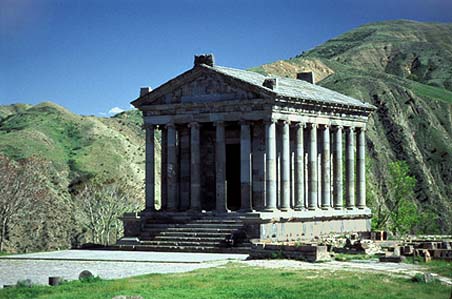Ancient Armenia of the Trans-Caucasus (original) (raw)
HOME / Table of Contents = Civilizations - Cultures - Areas - Regions - Prehistory
Other Archaeological Sites / The Neolithic of the Levant (500 Page Book Online)
Ancient Armenia

Ancient Roman Pagan Temple of Garni Near Yerevan (Capital of Armenia)
Historical Background

The Ancient Period
The first major state in the region was the Kingdom of Urartu which appeared around Lake Van in the thirteenth century BC and reached its peak in the ninth century BC. Shortly after the fall of Urartu to the Assyrians the Indo-European-speaking proto-Armenians migrated probably from the west onto the Armenian Plateau and mingled with the local people of the Hurrian civilization which at that time extended into Anatolia (present day Asian Turkey) from its center in Mesopotamia ...
Greek historians first mentioned the Armenians in the mid-sixth century BC. Ruled for many centuries by the Persians Armenia became a buffer state between the Greeks and Romans to the west and the Persians and Arabs of the Middle East. It reached its greatest size and influence under King Tigran II also known as Tigranes or Tigran the Great (reined 95-55 BC). Tigran and his son Artavazd II made Armenia a center of Hellenic culture during their reigns ...
By 30 BC Rome conquered the Armenian Empire and for the next 200 years Armenia often was a pawn of the Romans in campaigns against their Central Asian enemies the Parthians. A new dynasty however, the Arsacids, took power in Armenia in AD 53 under the Parthian king Tiridates I who defeated Roman forces in AD 62. Roman Emperor Nero then conciliated the Parthians by personally crowning Tiridates king of Armenia. For much of its subsequent history Armenia was not united under a single sovereign but was usually divided between empires and among local Armenian rulers.
